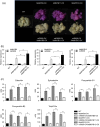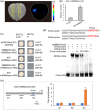The MdBBX22-miR858-MdMYB9/11/12 module regulates proanthocyanidin biosynthesis in apple peel
- PMID: 35527510
- PMCID: PMC9398380
- DOI: 10.1111/pbi.13839
The MdBBX22-miR858-MdMYB9/11/12 module regulates proanthocyanidin biosynthesis in apple peel
Abstract
Proanthocyanidins (PAs) have antioxidant properties and are beneficial to human health. The fruit of apple (Malus × domestica Borkh.), especially the peel, is rich in various flavonoids, such as PAs, and thus is an important source of dietary antioxidants. Previous research on the regulation of PAs in apple has mainly focussed on the transcription level, whereas studies conducted at the post-transcriptional level are relatively rare. In this study, we investigated the function of mdm-miR858, a miRNA with multiple functions in plant development, in the peel of apple fruit. We showed that mdm-miR858 negatively regulated PA accumulation by targeting MdMYB9/11/12 in the peel. During fruit development, mdm-miR858 expression was negatively correlated with MdMYB9/11/12 expression and PA accumulation. A 5'-RACE experiment, GUS staining assays and transient luminescent assays indicated that mdm-miR858 cleaved and inhibited the expression of MdMYB9/11/12. Overexpression of mdm-miR858 in apple calli, tobacco and Arabidopsis reduced the accumulation of PAs induced by overexpression of MdMYB9/11/12. Furthermore, we found that MdBBX22 bound to the mdm-miR858 promoter and induced its expression. Overexpression of MdBBX22 induced the expression of mdm-miR858 to inhibit the accumulation of PAs in apple calli overexpressing MdMYB9/11/12. Under light stress, MdBBX22 induced mdm-miR858 expression to inhibit PA accumulation and thereby indirectly enhanced anthocyanin synthesis in the peel. The present results revealed that the MdBBX22-miR858-MdMYB9/11/12 module regulates PA accumulation in apple. The findings provide a reference for further studies of the regulatory mechanism of PA accumulation and the relationship between PAs and anthocyanins.
Keywords: MdMYB9/11/12; MdBBX22; apple; light stress; mdm-miR858; proanthocyanidins.
© 2022 The Authors. Plant Biotechnology Journal published by Society for Experimental Biology and The Association of Applied Biologists and John Wiley & Sons Ltd.
Conflict of interest statement
The authors declare that they have no competing interests.
Figures








Similar articles
-
Mdm-miR858 targets MdMYB9 and MdMYBPA1 to participate anthocyanin biosynthesis in red-fleshed apple.Plant J. 2023 Mar;113(6):1295-1309. doi: 10.1111/tpj.16111. Epub 2023 Feb 2. Plant J. 2023. PMID: 36651024
-
The ethylene response factor MdERF1B regulates anthocyanin and proanthocyanidin biosynthesis in apple.Plant Mol Biol. 2018 Oct;98(3):205-218. doi: 10.1007/s11103-018-0770-5. Epub 2018 Sep 4. Plant Mol Biol. 2018. PMID: 30182194
-
MdMYB9 and MdMYB11 are involved in the regulation of the JA-induced biosynthesis of anthocyanin and proanthocyanidin in apples.Plant Cell Physiol. 2015 Apr;56(4):650-62. doi: 10.1093/pcp/pcu205. Epub 2014 Dec 19. Plant Cell Physiol. 2015. PMID: 25527830
-
Research progress of fruit color development in apple (Malus domestica Borkh.).Plant Physiol Biochem. 2021 May;162:267-279. doi: 10.1016/j.plaphy.2021.02.033. Epub 2021 Mar 4. Plant Physiol Biochem. 2021. PMID: 33711720 Review.
-
Regulatory Mechanisms of Anthocyanin Biosynthesis in Apple and Pear.Int J Mol Sci. 2021 Aug 6;22(16):8441. doi: 10.3390/ijms22168441. Int J Mol Sci. 2021. PMID: 34445149 Free PMC article. Review.
Cited by
-
Allelic variation in an expansin, MdEXP-A1, contributes to flesh firmness at harvest in apples.Mol Hortic. 2025 Jan 20;5(1):3. doi: 10.1186/s43897-024-00121-3. Mol Hortic. 2025. PMID: 39828743 Free PMC article.
-
gma-miR828a Negatively Regulates Resistance to Tea Leaf Spot Caused by Lasiodiplodia theobromae Through Targeting the CsMYB28-CsRPP13 Module.Mol Plant Pathol. 2025 Mar;26(3):e70069. doi: 10.1111/mpp.70069. Mol Plant Pathol. 2025. PMID: 40033647 Free PMC article.
-
The Smi-miR858a-SmMYB module regulates tanshinone and phenolic acid biosynthesis in Salvia miltiorrhiza.Hortic Res. 2024 Feb 23;11(4):uhae047. doi: 10.1093/hr/uhae047. eCollection 2024 Apr. Hortic Res. 2024. PMID: 38706582 Free PMC article.
-
The complexities of proanthocyanidin biosynthesis and its regulation in plants.Plant Commun. 2023 Mar 13;4(2):100498. doi: 10.1016/j.xplc.2022.100498. Epub 2022 Nov 26. Plant Commun. 2023. PMID: 36435967 Free PMC article. Review.
-
Expression profiles of microRNA-mRNA and their potential impact on anthocyanin accumulation in purple petals of Brassica napus.BMC Plant Biol. 2024 Dec 20;24(1):1223. doi: 10.1186/s12870-024-05922-8. BMC Plant Biol. 2024. PMID: 39707179 Free PMC article.
References
-
- An, J.‐P. , Wang, X.‐F. , Espley, R.V. , Lin‐Wang, K. , Bi, S.‐Q. , You, C.‐X. and Hao, Y.‐J . (2020) An apple B‐Box protein MdBBX37 modulates anthocyanin biosynthesis and hypocotyl elongation synergistically with MdMYBs and MdHY5. Plant Cell Physiol. 61, 130–143. - PubMed
-
- An, X.‐H. , Tian, Y.I. , Chen, K.‐Q. , Liu, X.‐J. , Liu, D.‐D. , Xie, X.‐B. , Cheng, C.‐G. et al. (2015) MdMYB9 and MdMYB11 are involved in the regulation of the JA‐induced biosynthesis of anthocyanin and proanthocyanidin in apples. Plant Cell Physiol. 56, 650–662. - PubMed
-
- Bagchi, D. , Bagchi, M. , Stohs, S.J. , Das, D.K. , Ray, S.D. , Kuszynski, C.A. , Joshi, S.S. et al. (2000) Free radicals and grape seed proanthocyanidin extract: importance in human health and disease prevention. Toxicology, 148, 187–197. - PubMed
Publication types
MeSH terms
Substances
LinkOut - more resources
Full Text Sources

